The Corsair Hydro X Custom Water Cooling Review, on a Ryzen 9 3950X
by Gavin Bonshor on February 5, 2020 9:00 AM EST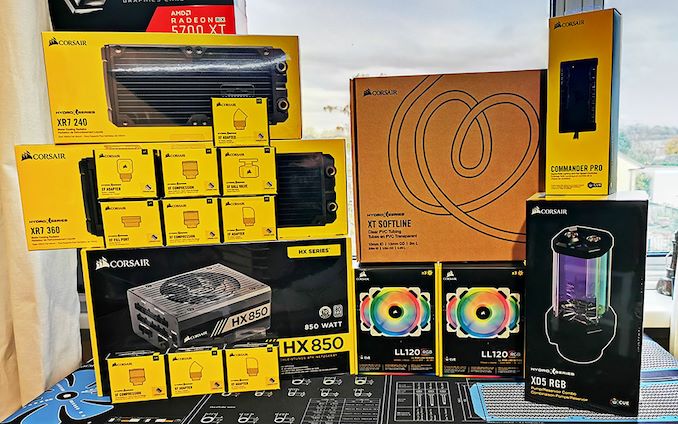
During Computex 2019, Corsair unveiled its new Hydro X series - a new range of water cooling hardware that markts its first entry into custom water cooling market. The range offers CPU blocks for multiple sockets, multiple fittings, tubing types, and a pump/reservoir combo, allowing users can build a high-performance system with nearly all Corsair branded parts. We used the Corsair Hydro X series in our ASRock X570 Aqua review and built a full system to showcase what Corsair is offering, and here is a build log of that system.
The Corsair Hydro X Series: Making a Big Splash
Widely known as one of the major players in the closed-loop cooler markets, Corsair made a big splash into the custom water cooling market with its Hydro X series last year. By offering a family of custom liquid parts that includes CPU blocks, GPU blocks, radiators, a pump and reservoir combination, to a range of coolant and fittings for users to select from to customize a full loop, Corsair is aiming to both undercut the competition but also be able to provide as much of the system as a Corsair as possible.
The Corsair Hydro X series is fully integrated to work with Corsair's iCUE RGB customization software which allows users to run Corsair RGB fans, the Hydro X series, as well as link up devices such as Corsair peripherals. Most companies that use RGB as one of its driving features are focused on creating an immersive ecosystem so that its RGB laden product families can be managed through a single interface. The Corsair Hydro X range, unlike other water cooling brands, is primarily constructed of nylon which as a material, which Corsair claims is more durable and easier to produce in higher quantities.
All of Corsair's Hydro X Series water blocks come with G1/4" threads, and each block has thermal materials pre-applied for ease of use.

Corsair Hydro X Series XC7 CPU Block for LGA115x and AM4
On CPU blocks, Corsair has two series of CPU blocks: the Hydro X Series XC7, and the Hydro X Series XC9. The Corsair Hydro X Series XC7 comes in three varieties, one for Intel's HEDT LGA2066 socket, one for AMD's HEDT sTR4 socket, and a final one designed for both Intel socket LGA115x and AMD AM4 sockets.
The Hydro X Series XC7 includes RGB LED lighting and has 60+ cold plate fins. The XC7 uses nickel-plated copper so compatibility is limited to other water cooling products that use copper and brass internally. The XC7 is available at present in black, while the XC9 comes in silver.

Corsair Hydro X Series XC9 CPU Block for LGA2011/2066 and sTR4/sTRX4
The second of two available processor blocks is the Corsair Hydro X Series XC9 CPU block. This is higher-end in terms of specifications, and is designed solely for the Intel LGA2066 and AMD sTR4 platforms. With a larger than average nickel-plated copper cooling plate designed for larger and more powerful processors, the XC9 has more cooling fins. Like the XC7, the XC9 has a transparent flow chamber for users to see water flow, but the XC9 also has a sandblasted aluminium trim designed to have a more premium look and feel. Again, RGB LEDs are present.
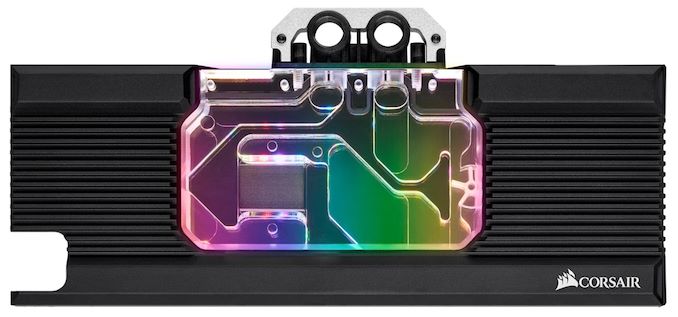
Corsair Hydro X Series XG7 RGB 2080 Ti Founders Edition GPU Block
The XG7 series represents its custom solution graphics card water blocks and although it doesn't support every available model, there is an XG7 model for reference NVIDIA GeForce RTX 2070, 2080, and 2080 Tis. Corsair also has custom variants for the ASUS ROG RTX 2080 and 2080 Ti STRIX models. For the AMD side, only one block is available and has support for reference AMD RX 5700 XT. Each block is constructed from nickel-plated copper, with a full aluminium backplate and comes with 16 integrated individually addressable RGB LEDs. For added style, the block itself has a transparent front cover to allow users to see the flow, and show off colored coolant.
At present, Corsair is offering a single pump and reservoir solution through the Hydro X Series XD5. This includes a Xylem D5 PWM pump with a 330 ml capacity reservoir. Like the majority of the range, the fluid chamber is constructed from Nylon. The the flow rate is advertised as 800 L/h at 2.1 meters of pressure. The Xylem D5 PWM pump is rated up to a maximum of 4800 RPM, and has a power draw of around 30 W. Integrated into the reservoir are ten RGB LEDs which can be controlled by the Corsair iCUE RGB software, and hook up to directly to Corsair's iCUE lighting controller.
Included with the pump are mounting brackets to allow users to mount it in various parts of a system including in drive bays and on 120/140 mm cooling fans. Also supplied is an in-loop temperature probe and a 24-pin power supply jumper so users can fill up without having to power the system components on. This is important for debugging any issues with a loop.
The Corsair Hydro X Series offers two main types of core fittings and tubing. This includes Softline in 10/13 mm ID/OD, and hardline in 14/10 mm. The Hardline is constructed from PMMA, while the Softline is made from PVC. There is a wide variety of fittings to allow users to create the right configuration including 45° and 90° angled fittings, as well as rotary splitters, ball valves, and a fill port.
The fittings themselves are constructed from brass and are G1/4" thread. Each core fitting is knurled brass and is available in both silver and black varieties. Corsair states that its range should only be used with other parts constructed from copper and brass to avoid mixing metals which can cause corrosion.
It wouldn't be a full water cooling series without radiators, and Corsair is offering its slim 30 mm XR5 radiators in six sizes including 120, 140, 240, 280, 360, and 420 mm. The thicker XR7 radiators are available in 240 mm, 360 mm and in a larger 480 mm size. Each XR7 radiator is 54 mm thick and is constructed from copper and brass, with support for 120 mm cooling fans. Dependant on the size and space inside the chassis, each radiator supports both push and pull for better cooling performance. At present, the radiators are only available in black.
The Corsair Hydro X Series XL5 coolant is manufactured by renowned fluid specialist Mayhems Solutions and is available in clear, and four colors. This includes red, green, blue and purple and each bottle is available in 1 liter capacities.


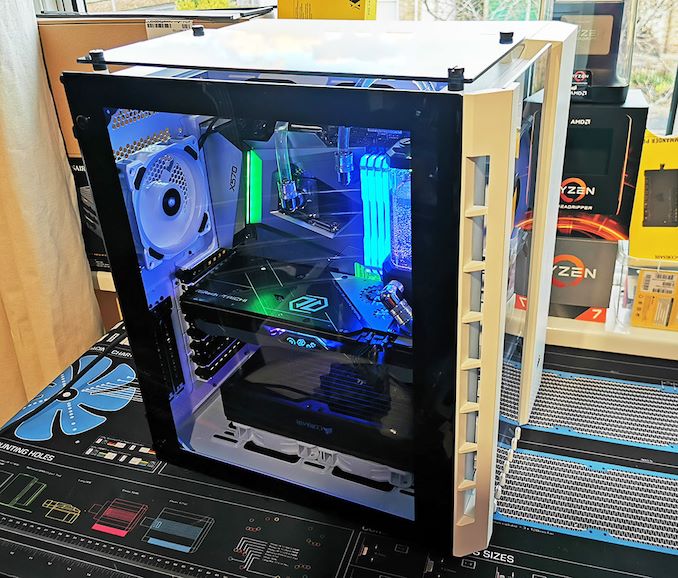
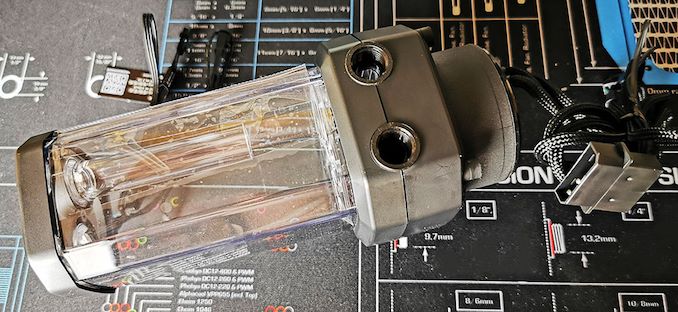
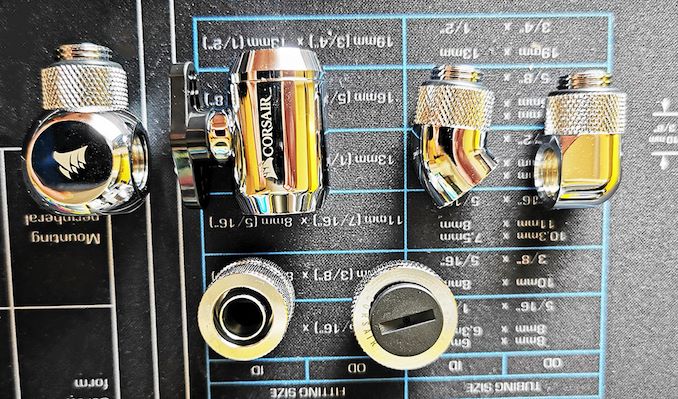
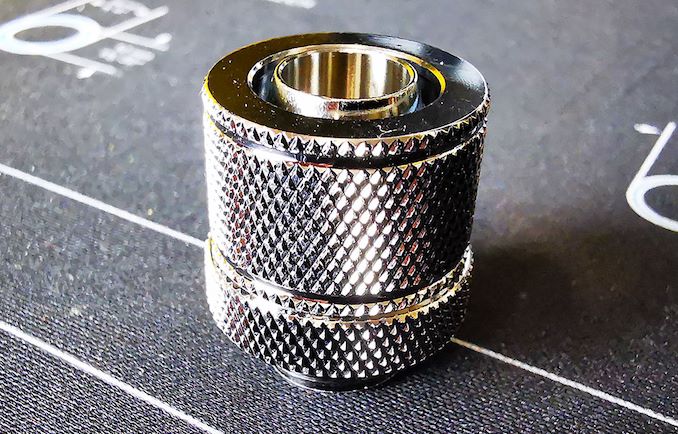
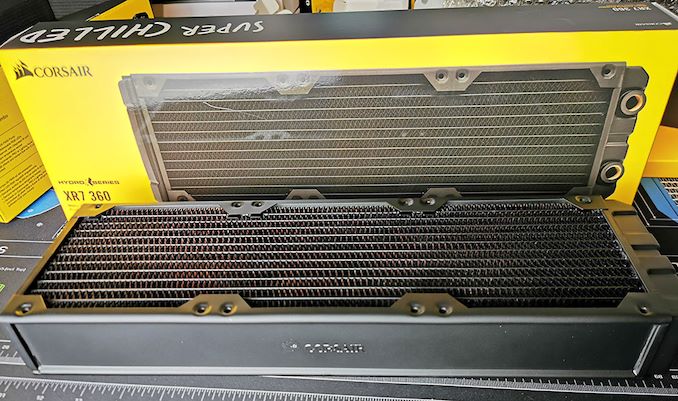









72 Comments
View All Comments
airdrifting - Wednesday, February 5, 2020 - link
"The cooling performance was also astronomical (can't break 52 C under max load on GPU w/overclock)"?Shill detected. I have never been able to break 52 C under load with ANY custom liquid cooling on a flagship GPU, that includes all titans and flagships from 780 Ti to 2080 Ti, the highest I get is like 47C. Even with the EVGA Hybrid cards with AIO liquid cooling and 120mm radiator, you will never see 55C in most cases.
The cooling performance in a custom liquid cooling loop is not just about the radiator, the fans, pump, block, the shape of the loop all matters. Using a mediocre load temperature to claim the radiator is good is absurd, and I have seen anyone talking about "screw/tube protectors" on a radiator, wtf is that? If you are talking about the little metal shield underneath the screw hole but above the fins, that is completely useless because you can simply have the screw holes spaced between the fins instead of the tiny tubes like every single radiator is doing nowadays. Even if the screws are too long they will just bend the fins which doesn't really matter as long as they don't pierce the tube.
brontes - Wednesday, February 5, 2020 - link
Wait, how is he a shill if you're the one getting better performance?Anyway, Corsair rebadges hardwarelabs rads. They swap out to thicker screw channels to reduce the chance of puncture in case you for some reason have a three year old with power tools doing the installation sideways, and they include longer screws for push+pull in the box. And they put their logo on it. Other than that, it is a HWL product.
AshlayW - Thursday, February 6, 2020 - link
How is he a shill if he's not putting the product in the best possible light? Shut up.PeachNCream - Wednesday, February 5, 2020 - link
$500+ in order to run an overclock that may work on a cheaper cooler or even on air cooling that ultimately gains 5% in a couple of benchmarks. Yes, it looks cool. Yes, you can say you put together a custom cooling loop. That's a lot of effort, resources, and time for little reward over not overclocked parts running an inexpensive air cooler.airdrifting - Wednesday, February 5, 2020 - link
Try 2%. With turbo boost and Intel falling behind in nm technology, there is very little OC headroom for processors like 9900K which is already pushed to the limit at 4.7GHz all core. AMD's PB does a better job than manual OC most of the time. Video cards are wattage capped so it's not like raising the voltage or core frequency does much, MSI AB doesn't work on most of the cards when it comes to raising TDP.LedHed - Wednesday, February 5, 2020 - link
Many cards can have their power limit raised to 108% of the stock rating using Afterburner. However, like you said, there are cards that won't allow you to raise that limit at all. There are also cards that allow you to raise the limit up to 112%, so it goes both ways.I do agree that using dedicated H2O setups on current generation cards will be disappointed by their OC gains. This is due to how tight the power constraints were on the last 2 or 3 generations of NV cards. Well, unless you are willing to take a soldering iron to their GPU, then all bets are off! Voltage mods are a lot of fun, as long as you don't kill the card!
liquid_c - Wednesday, February 5, 2020 - link
I can guarantee you that almost all of the 9900k on the market can reach an all-core 5ghz OC, even those from lots sold after the launch of the 9900ks. You do need a *solid* cpu cooler and if you live in a place with high ambient temps then you’re facing an uphill battle.My own personal recommendation would be to use at least a 280mm AIO for the CPU alone, in this use case (Kraken X62, H115i, etc.), with these beefy CPUs.
airdrifting - Thursday, February 6, 2020 - link
Only when you use a 360mm or better liquid cooling. I have handled many 9900K, single 120mm rad is not enough to keep most under load without overclocking, you will see instant 90C+. 240mm rad is probably the minimal for 9900K unless you want to undervoltage. It's just not worth it to get a 0.3GHz OC for so much hassle. On the contrary, H60 can easily keep 3700X under 65C.brontes - Wednesday, February 5, 2020 - link
Its not about OC these days, it about RGB/bling or silence. And I've discovered for a vast majority of the bling people, its not a "set it and forget it" deal, but much closer to a hobby. They're constantly tinkering and rearranging and replacing with the latest unicorn vomit fans and such. "Old" cooling parts build up and then its a challenge to watercool some old system with an "unfriendly" case they had sitting around that doesn't even actually get use. And so on. Hey, its their money and they're having fun, so whatever. And because they spend lots of money on tons of various parts, you can get good advice from from people with lots of first hand experience with different products very easily.I'm one of the uncommon ones that just wants it to work, without lights.
Its honestly a little creepy at first. After 30 years of the computer responding to heavy loads (esp. on the gpu) with *some* sort of noise its just.. not there anymore.
It is certainly a hell of a lot cheaper if noise doesn't bother you and you stick to air. But alas, the initial outlay is done. That aside, maintenance is easier/less frequent than I expected with some silly tricks as well as not using colored fluid. I'm looking at +$200 on each socket+gpu swap for blocks, which isn't terrible considering a good CPU HSF or AIO is $80-150, and there isn't even a comparable option for the GPU or chipset unless you get "creative."
But yeah, "home overclocking" is pretty much dead and any extra additional headroom from watercooling is considered a tertiary fringe benefit.
FatBoyDiesel - Wednesday, February 5, 2020 - link
Not gonna lie, I went full RGB so I could set the color scheme to the colors of the Ryzen Halo logo. It worked best in a case like the Thermaltake Core V1, I replaced the stock 200mm fan for a faster 200mm Riing Plus RGB fan and got the effect to work nicely.Then I upgraded to the Nouvolo Steck. I got a 240mm H100i v2 for it and appreciated the extra RGB (RAM, motherboard, AIO). However, I didn't like the extra cost and didn't need the extra RGB per se. I went for a custom loop, with the fans being the first to be replaced with regular fans. My blocks are RGB, sure, with the XC7 requiring the Lighting Node Pro. That thing was what I wanted with 4 RGB strips with a tiny RGB controller to fit in a small space for such a compact build. I honestly thought about simply abandoning most RGB components in the future save RAM and my Lightning Node Pro. The cost of RGB on everything is so dumb to me. I also don't like unicorn vomit.